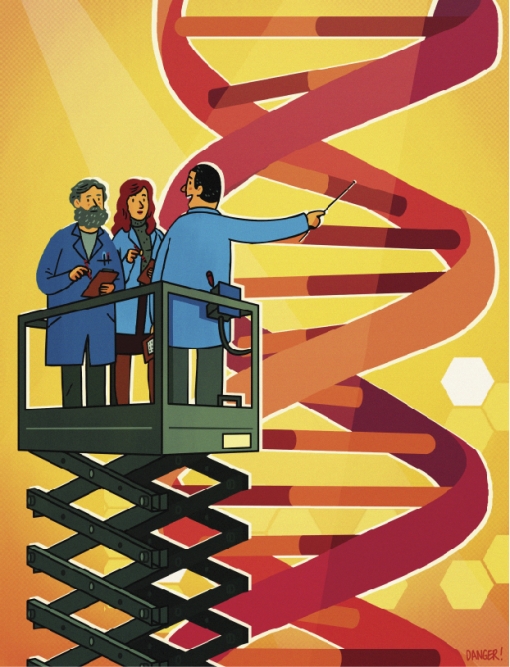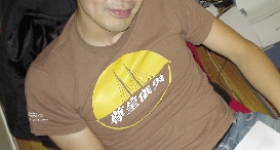Writer Dharushana Muthulingam
Illustrator Chris Danger
In the 1997 science fiction movie Gattaca, set in a future of genetically engineered humans, Vincent Freeman — the unfortunate product of “natural conception” — declared: “I belonged to a new underclass, no longer determined by social status or the color of your skin. No, we now have discrimination down to a science.” It is a touching picture of dystopia, where we have moved beyond our current social myopias, only to find new, more elaborate ones.
In 1997, the race to map the human genome — the entire hereditary information of humans — was in full force. It held the promise of better medicine, better technology and a better idea of where we come from. But a long history of discrimination by social status and skin color still had an unwitting effect in shaping science.
Genetics has only recently had concrete applications in medicine and everyday life. By the mid-2000s, the price of genetic testing decreased steeply enough to make it usable outside of research. Now, we can identify which specific breast cancer variant will respond to a certain treatment or predict if an HIV medication will cause a bad reaction.
The potential for Personalized Medicine was born on these few successes, with slick promises of customized treatment for what ails you. This has also improved the well-being of a handful of stockholders, with the nascent industry estimated to be worth $232 billion and growing 11 percent annually.
One portion of this industry is direct-to-consumer genetic testing. You send companies like Navigenics, 23andMe and deCODEme some spit and a few hundred dollars (the price falls every year). Someday soon, pending Food and Drug Administration approval, you’ll just pick up a kit from the drug store.
These companies then report back your genetic risks for diseases like Alzheimer’s, dementia, a profile of your ancestors, fun facts (dry or wet earwax) and also a few data points traditionally in the domain of psychological self quizzes. 23andMe, for example, claims to answer these questions: Do you have the gene that determines increased intelligence if breastfed as a baby? Do you avoid errors? These questions are perhaps getting at what we really want to know — do our genes tell us who we are?
Much is promised about your future bodily doings and destiny, from cancer treatment to the composition of your soul. But is the promise really for you? I mean you, specifically?
It is — if you are Northern European. According to a 2009 review by Duke University geneticist David Goldstein, over 96 percent of the samples used in these genome-wide association studies (or tests of common genetic variants among individuals to see if any are associated with a trait) come from individuals with European ancestry.
That’s right: Only 4 percent of the world’s human genome database comes from people with ancestry from Southern Europe, the Americas, Africa, Asia or Australia.
This is likely an unintended artifact of where the science has been conducted so far and what populations have been historically accessed. The result is a profound sampling bias, overlooking variations and patterns and limiting the populations to which we can apply the data. It also means missing out on a potentially amazing discovery.
For example, there exists a rare mutation in the CCR5 gene on white blood cells that provides resistance to the effects of HIV. The mutation exists almost entirely in those with Northern European ancestry. Studying the gene has contributed to an entire new class of HIV medication. What rare, beneficial mutations are we missing in other populations?
It is also probably a bad business model to ignore large portions of your market. Direct-to-consumer genetic companies rely on the same general databases and scientific literature as researchers, in addition to their own test pools.
A Touchy Subject
Geneticist and policy analyst Susanne Haga finds that as of 2010, 16 of the 22 diseases for which 23andMe tests only apply to people of European ancestry. DeCODEme fared slightly better with 11 out of 22. At a presentation at a consumer genealogy conference in 2011, 23andMe reported only 1,000 self-identified African Americans on file, a much lower proportion than the general US population. (The Silicon Valley-based company did fair better among people who identify as Asian, with six to nine times that of more general databases.)
One possible reason for this imbalanced representation is a lurid past. The last few times race and biology paired up in history, bad things happened, on the order of slavery, colonization, genocide and the Tuskegee syphilis studies.
Razib Khan, science blogger and founder of African Ancestry Project, said: “Human population structure is fraught (let’s be frank, it used to be called ‘race science’) in part because earlier generations of scientists became public intellectuals in eugenic policy. When eugenics became taboo, so did the science which was drafted into its service.”
To its credit, the National Institute of Health has repeatedly tried to tie funding to increasing diversity in research subjects since the 1970s, with mixed results. This long shadow of history and the general societal conversation of race still shape the culture of how scientists approach race and which people are willing to sign up as subjects.
This caution may have been the prudent thing, but it may have also slowed down investigations that are biologically valid and in fact, facilitate a more just and accessible science. The last 10 years have seen an astonishing rise in the health research of minority populations and disparities due to social class, and the genetic database is only just starting to catch up.
Another barrier is having a misleading taxonomy: the trouble with getting your racial categories right. While there is some relation between your geographical lineage and your collection of genes, the traditional American racial categories like “white” and “Hispanic” are historical artifacts that do not map rigorously to anything in the natural world, even as they shape our society.
This was suspected by famed evolutionary biologist Richard Lewontin in 1972 and confirmed in a 2004 analysis that found that there is more genetic variation within each of those categories than there are differences between any two categories. Of course, people mix across categories, which complicates genetic profiles.

Illustration by Chris Danger
Risky Business
Melinda Yang, a graduate student in evolutionary biology at the University of California, Berkeley, said: “[Finding] genetic differences by populations is based on statistics. Thus, with pretty defined groups, like Spanish vs. Japanese, you can be pretty confident in the results, but the more mixing that may have occurred in the past between two populations, the harder it will be to be very confident in the genetic divisions drawn.”
For all these important reasons for having a diverse genetic database — accuracy in research, finding unique mutations and, yes, a more marketable consumer genetic industry — there is also the sense that race is only one tiny lens among many to view the data. Since the Human Genome project was completed, they found that over 99.5 percent of genes are identical across human kind.
“Yet, almost as soon as researchers announced this result, several research projects began to focus on mapping the less than one percent of human genetic variation onto social categories of race,” Osagie Obasogie, a professor of law at UC Hastings, noted in GeneWatch Magazine in 2009.
Despite the fact that social categories of race do not match genetic categories, and despite the existence of far more similarity than difference among these social categories, a lot of effort has gone into trying to dig up what minuscule matching does exist.
Not only are the old categories of race too rough and misleading for modern biological work, there is a risk for what sociologist Troy Duster calls the “reification of race” — a circular process of using a popular understanding of race (shaped by hundreds of years of custom, biases and so on) to shape the scientific questions and research funding, which then gives an aura of legitimacy to that pile of unexamined biases.
The risk is real. Geneticist Carlos D. Bustamante of Stanford University, a leader in pushing forward diversity in the global genomics database, received a cheerful letter from David Duke, a former director of the Knights of the Ku Klux Klan, thanking him for illustrating the importance of the biological differences between races.
We want our research to reflect the truth of our diversity, but if we do it in a sloppy way, we risk invoking a heavy history of biases that have very real consequences.
Looking to the Future
Change has been brewing. Countries like India and Mexico have launched “national genomic sovereignty,” building national genomic databases that reflect their own populations.
In 2008, a global effort that included NIH, British trusts and Chinese institutes launched the 1000 Genomes Project, a five-year project to get an equally representative database of people from East Asia, West Africa, the Americas and South Asia.
It’s not quite everyone, but it’s certainly more diverse than a database that is 96 percent Northern European. 23andMe has launched the Roots project. Partnering with the W.E.B. Du Bois Institute of Harvard and recruiting several prominent leaders in genetic research (all people of color), 23andMe hopes to give away 10,000 free kits to African Americans to build their databases.
Congress has reviewed the Genomics and Personalized Medicine Act, which would create a working group to find better biological categories to think about diversity, improve access to clinical trials for minority populations, support research in those populations and protect privacy. On the other hand, the act didn’t pass in 2006 — or in 2007, 2008 or 2010, when it finally died in committee.
The United Kingdom has achieved more progress, with the Human Genetics Commission developing a framework for best practices for direct-to-consumer genetics.
There are also rogue genomicists who seek to democratize the project. Razib Khan started the African Ancestry Project because the direct-to-consumer companies weren’t providing good service; Zack Ajmal started the Harappa Ancestry Project for South Asian ancestry for similar reasons.
“It serves as a ‘bottom-up’ pressure,” Khan said. As the tools for genetic sequencing become rapidly cheaper (they may soon show up at your local drugstore), accessibility may breed diversity.
Genetics is still a relatively crude science in figuring out our health and identity. We are not just our DNA. We are also our physiology, our education, the people we love, the cigarettes we smoke, our skin color in history, the fierceness we can conjure, the pollutants in our city and the mess of personality, trajectory and sheer luck that culminate and interact with the fragile molecules of our genome.
Even in such a crude tool, inclusion becomes critical, especially if sweeping promises of better medicine and technology do some day pan out. Institutions of power have long not seen “us” — people of color, women, the un-standardized. How dreadful would it be if science had the same blindness? The laboratories are not immune. The work continues.
Dharushana Muthulingam is Hyphen’s health editor.









Comments